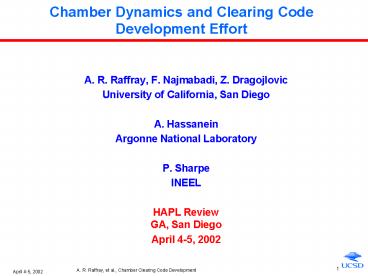Chamber Dynamics and Clearing Code Development Effort - PowerPoint PPT Presentation
1 / 13
Title:
Chamber Dynamics and Clearing Code Development Effort
Description:
April 4-5, 2002. A. R. Raffray, et al., Chamber Clearing ... dissipation. Mass. input. Mass Conservation Equations (multi-phase, multi-species) Evaporation, ... – PowerPoint PPT presentation
Number of Views:14
Avg rating:3.0/5.0
Title: Chamber Dynamics and Clearing Code Development Effort
1
Chamber Dynamics and Clearing Code Development
Effort
- A. R. Raffray, F. Najmabadi, Z. Dragojlovic
- University of California, San Diego
- A. Hassanein
- Argonne National Laboratory
- P. Sharpe
- INEEL
- HAPL ReviewGA, San Diego
- April 4-5, 2002
2
Chamber Physics Modeling
3
Chamber Dynamics and Clearing 2001 Statement of
Work (I)
Statements of work Initiate development of a
fully integrated computer code to model and study
the chamber dynamic behavior. Deliver the
core of the code including the input/output
interfaces, the geometry definition and the
numerical solution control for multi-species
(multi-fluid), 2-D transient compressible Navier
Stokes equations. Scoping studies to assess
importance of different phenomena for inclusion
in the code. Develop simple modules defining
the physics of the different phenomena.
Single species code with rectangular domain
completed using progressive approach - 1-D
--gt 2-D - inviscid --gt viscous (to be
presented by Z. Dragojlovic)
Results presented at last meeting for poor
effectiveness of conduction, convection and
radiation to cool protective gas
4
Chamber Dynamics and Clearing 2001 Statement of
Work (II)
Wall interaction module developed as 1-D
transient thermal model with ion and photon
energy deposition, including melting and
sublimation effect Scoping analyses performed to
decide on relative importance of other erosion
mechanisms (ANL) Sputtering and RES modeling
equations provided by ANL, to be coded at
UCSD (to be presented by R. Raffray)
Statements of work Provide modules for
chamber wall interaction modules which will
include physics of melting evaporation and
sublimation sputtering macroscopic erosion and
condensation and redeposition. Scope the
range of chamber dynamics and clearing
experiments that can be carried out in a facility
producing 100-1000 J of X-ray.
Completed (to be presented by F. Najmabadi)
5
Wall Interaction Module Has Been Developed
Ion and photon energy deposition calculations
based on spectra - Photon attenuation
based on total photon attenuation
coefficient in material - Use of SRIM tabulated
data for ion stopping power as a function
of energy Transient Thermal Model - 1-D
geometry with temperature-dependent
properties - Melting included by step increase
in enthalpy at MP - Evaporation included based
on equilibrium data as a function of surface
temperature and corresponding vapor
pressure - For C, sublimation based on
latest recommendation from Philipps Model
calibrated and example cases run To be
linked to gas dynamic code
6
Other Erosion Processes to be Added (ANL)
Scoping analysis performed - Vaporization,
physical sputtering, chemical sputtering,
radiation enhanced sublimation
Plots illustrating relative importance of erosion
mechanisms for C and W for 154 MJ NRL DD target
spectra Chamber radius 6.5 m.
CFC-2002U
These results indicate need to include RES and
chemical sputtering for C (both increase with
temperature) Physical sputtering relatively
less important for both C and W for minimally
attenuated ions (does not vary with temperature
and peaks at ion energies of 1keV)
Tungsten
7
Models Provided for RES, Chemical Sputtering and
Physical Sputtering (ANL)
Recommended models (equations) provided for
inclusion in wall interaction module for
physical and chemical sputtering and
radiation enhanced sublimation - Model
based on analytical and semi-empirical approach
Calibration runs will be done Further
effort required for macroscopic
erosion - Scoping analysis - Model
development
8
Comparison Runs for Energy Deposition and Thermal
Analysis (UCSD, UW and ANL)
Prior results did not match very well We
decided to - Compare input data and resolve
any differences - Run a few example cases for
energy deposition and temperature
calculations Stopping power and energy
deposition quite consistent now Very useful
exercise
9
Spatial Profile of Volumetric Energy Deposition
in C and W for Direct Drive Target Spectra
Tabulated data from SRIM for ion stopping power
used as input
10
Spatial and Temporal Heat Generation Profiles in
C and W for 154MJ Direct Drive Target Spectra
Assumption of estimating time from center of
chamber at t 0 is reasonable based on
discussion with J. Perkins and J. Latkowski
11
Temperature History of C and W Armor Subject to
154MJ Direct Drive Target Spectra with No
Protective Gas
Initial photon temperature peak is dependent
on photon spread time (sub-ns from J. Perkins
and J. Latkowski)
12
Future Effort (1)
Document and release stage 1 code Exercise
stage1 code - Investigate effectiveness of
convection for cooling the chamber gas - Assess
effect of penetrations on the chamber gas
behavior including interaction with
mirrors - Investigate armor mass transfer from
one part of the chamber to another including to
mirror - Assess different buffer gas instead
of Xe - Assess chamber clearing (exhaust) to
identify range of desirable base
pressures - Assess experimental tests that can
be performed in simulation experiments
13
Future Effort (2)
Implement development of stage 2 code -
Extend the capability of the code (full
inclusion of multi-species capability) - Impleme
nt adaptive mesh routines for cases with high
transient gradients and start implementation
if necessary - Work with INEEL to implement
aerosol formation and transport models in the
stage 2 code - Low probability for aerosol
formation for dry wall concepts - However,
major effect on target and driver even with
minimal formation - Possible background plasma
effect to slow down and stop ions (behavior of
these particles) - Work with ANL to
implement more sophisticated wall interaction
models in stage 2 code - Brittle
destruction of carbon-based material - Droplets
formation and splashing for metallic
walls Develop a 0-D multi-species model to
assess the range of species (neutral and
plasma) that should be taken into accounts (S.
Krasheninnikov) - If plasma effects are shown
to be important, implement model in chamber
dynamics code































